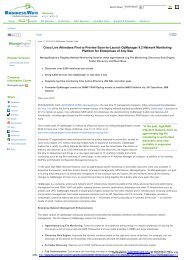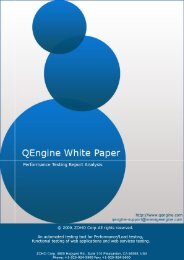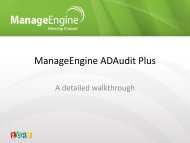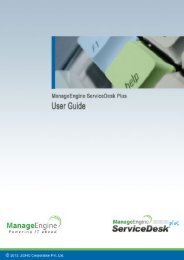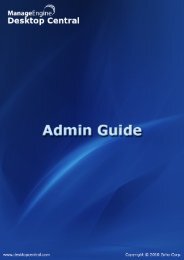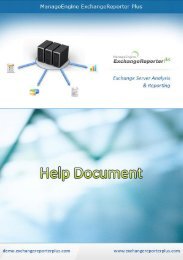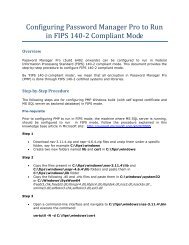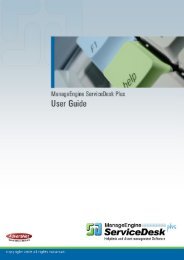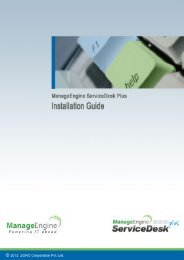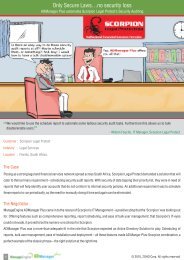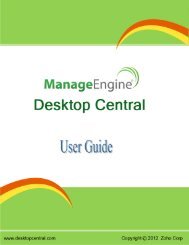ManageEngine ADManager Plus :: Help Documentation
ManageEngine ADManager Plus :: Help Documentation
ManageEngine ADManager Plus :: Help Documentation
Create successful ePaper yourself
Turn your PDF publications into a flip-book with our unique Google optimized e-Paper software.
Viewing/Modifying User Templates<br />
To view or to modify the user templates,<br />
<strong>ManageEngine</strong> <strong>ADManager</strong> <strong>Plus</strong> :: <strong>Help</strong> <strong>Documentation</strong><br />
1. Click the AD Mgmt tab.<br />
2. Click the View User Template link available under Create Template. This will<br />
list all the templates that were created.<br />
Tip: You can sort the templates in ascending/descending order using the arrow<br />
icon near the Template Name heading.<br />
3. Click on the last icon under Action heading, to set that particular template as the<br />
default template.<br />
4. To modify the template click the template name or the icon to open the Modify<br />
User Template dialog.<br />
5. Modify the attributes as required and click Save Template.<br />
Note: The modification to the attributes will not modify the user attributes<br />
of the users created prior to modification of the template. This applies to<br />
the users created henceforth using this template.<br />
User Creation with Advanced Permissions: While creating User template you can<br />
assign advanced permissions and share properties, and eventually all the users created<br />
with those template will bear those permissions.<br />
You will find these advanced permissions available in the following places:<br />
Advanced features in User Creation:<br />
For Profile path:<br />
Profile path specifies a Uniform Naming Convention (UNC) name, such as<br />
\\Server\Prof$\%username%, to be the network folder where the user's roaming profile<br />
is stored. This way, user's roaming profile is downloaded to whichever workstation he<br />
logs onto and it is uploaded back to the server when he logs off. The dollar sign ($) in<br />
the Prof$ sharename makes it invisible so that users don't browse it.<br />
Configuring the property "Profile path":<br />
1. "Profile path" attribute can be found in the "Account Details" tab of "Create<br />
Template" wizard.<br />
2. While specifying profile path click on 'Permissions' adjacent to it, this will open a<br />
window for profile path settings.<br />
3. check in the box to Create Profile Path Directory before user first login<br />
4. you can add more permissions by selecting the tab 'Permissions' to Add More<br />
Permissions'.<br />
5. This leads you to set of options where in you can allow a selected user or group<br />
or computer, to have permissions like full control, read attributes, delete etc, over<br />
folder and its descendants.<br />
6. Click on Add.<br />
7. Check in the Box below to Inherit from parent the permission entries that apply<br />
to child objects.<br />
ZOHO Corp. 74




